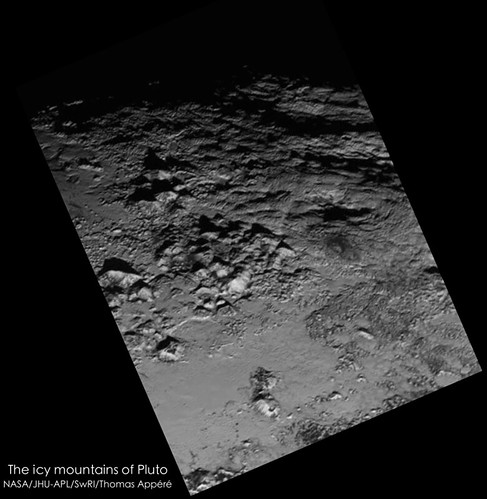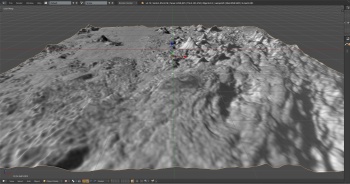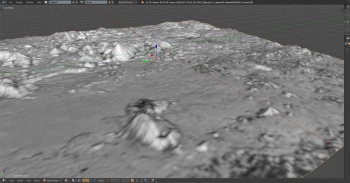QUOTE (neo56 @ Jul 15 2015, 09:04 PM)

My take on the amazing LORRI picture of Pluto:

Thomas thats brilliant. The change of view makes it so much easier to understand. When I zoomed in on the ropey like background, there are thousands of little sublimation pits that are arranged in twisted lines just like rope. These very high hills, remember the ice shards in the foreground are over a kilometre tall, look distinctly depositional. This is millennia of super volatile frost/snow deposition. We have seen these sublimation features, shapes, pits, sedimentary like layering all over 67P, an object dominated by the sublimation of volatiles. We also see in the area that is the very tip of the Tombaugh Region, a grey coating that looks to have "flowed" over and covered underlying terrain, flowing round the Ice Mountains giving the appearance they are emerging from the surface. There are holes in it around the edges through which the loopy ridges of the terrain underneath can be seen, like lava tubes have holes in their tops, as well as underlying forms being visible in the surface topology. Whatever that grey stuff is, Carbon Monoxide Ice I suggest, has flowed down from the bright Tombaugh Region. The sharp angular shards of the Ice Mountains seem totally alien and randomly scattered in this landscape. Are they shards of Charon's Water Ice crust that broke off and embedded themselves in the terrain when the graze between Pluto and Charon occurred as mentioned earlier? This image right at the tip of the original heart shape is just at the edge of the first point of impact of my proposed graze of Charon. It would explain a lot, without resorting to energy sources and tectonics that have, for good reasons, been thought unlikely.
DLD, those experimental images were spot on, I learned so much from them. So Charon does have an "Eyeball" planet nature, even if, as I suggested previously, on a much smaller scale than Pluto. The two mountain ranges either side of the equator and the depression around the equator. Phil's contrast image appears to show dark plumes all over the hemisphere associated with dark circular features that could be volcanos or geysers, their direction of travel being all pretty much from pole to equator as the movement of warm gas in the sunlit hemisphere moving to the colder unlit hemisphere would enable. DLD's July 9 image shows the surface made of large plates and many of those cracks/faults can be seen in the new Charon image, and most possible Cryovolcanic activity is seen along them. This could just be deposits left eons ago when Charon had more internal heat, but it seems the team think that activity is recent, if not current. Along the deep valley of the equator a large crack is marked by the dark spots of sublimation vents/pits. Whatever is under Charon's Water Ice crust looks to be very slowly venting to the surface and is contributing to the resurfacing of Charon. Charon's nano atmosphere might not be quite so tiny as I thought. The Alice results will be intriguing.
That plume on the Pluto image looks similar, but with such a tenuous atmosphere surely all the plumes would be thinner, like the ones from geysers on Triton. Maybe the atmosphere on Pluto is far more turbulent due to the huge elevation changes and latent heat released by freezing gases, but on Charon? With 3 to 4 Km deep canyons and chasms, as detailed by the team, thats going to stir up whatever atmosphere there is there too. That canyon at 2 O'Clock looks to have been formed by a shattered piece of crust that did not quite escape from Charon during the graze with Pluto. It is adjacent to the impact area.
It was mentioned earlier, that the dark patch is not where the North Pole should be on Charon. The patch is dark because of the impact not because its a polar icecap, it just happens to be in the North Polar region. The depression gouged out by the impact is so clearly visible on the magical images folks have posted here, the mountains forced up around the perimeter too. The conclusion has to be that Charon formed separately from Pluto and was trapped into orbit around Pluto after the grazing impact in the Tombaugh Region. Charon's composition suggests it formed nearer to the Sun and was perhaps caught by Pluto as it was ejected from there by the antics of Jupiter and Saturn that created the Kuiper belt.
I hope people don't mind me thinking out loud in this way, its purely to generate ideas and give different perspectives and I make no claims to being scientifically rigorous or even right, just awestruck at what these images could be telling us about this amazing place. I am just so grateful to those who take the time to process and produce these "enhanced" images. Most of all a great big THANK YOU to the NH team for their brilliant foresight and dedication.

_color_cropped.jpg)





